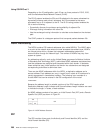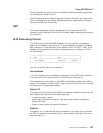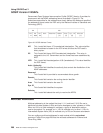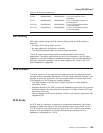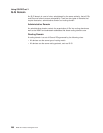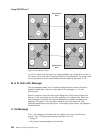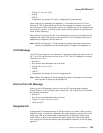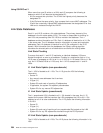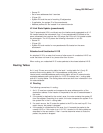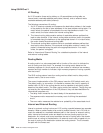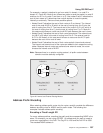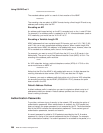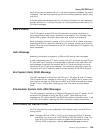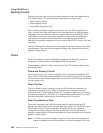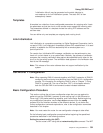When more than one IS exists on a LAN, each IS compares the following to
determine which IS will become the designated IS:
v All ISs compare their priorities. The IS with the highest priority becomes the
designated IS.
v If the ISs have the same priority, they compare their source MAC addresses. The
IS with the numerically highest MAC address becomes the designated IS for that
LAN and is indicated through the LAN ID.
Link State Databases
Each L1 and L2 IS contains a link state database. The primary element of the
database is the link state update (LSU). The router is responsible for building its
own LSU and processing other ISs’ LSUs to maintain the database. The L1
database contains information on ESs. Each L1 database is identical for all L1 ISs
in the same area. The L2 database contains information on areas and reachable
addresses. Each L2 database is identical for all L2 ISs configured in the IS-IS
domain. With information from the databases, the Dijkstra routing algorithm
calculates the shortest paths to all destinations and builds the routing tables.
Link State Flooding
To ensure that each L1 and L2 IS maintains an identical database, LSUs are
flooded throughout an area or a backbone. Flooding is a mechanism that an L1 or
L2 IS uses to propagate an LSU to all L1 or L2 ISs. An L1 IS floods LSUs to L1 ISs
only. An L2 IS floods LSUs to L2 ISs only. An L1/L2 IS accepts both L1 and L2
LSUs.
L1 Link State Update (non-pseudonode)
The L1 LSU is flooded to all L1 ISs. The L1 IS gives the LSU the following
information:
v Source ID
v Any manual area addresses that it services
v IS type (L1)
v System IDs and costs of reaching IS adjacencies
v If applicable, the system IDs adjacent pseudonodes
v System IDs for any manual ES adjacencies
L1 Link State Update (pseudonode)
The L1 pseudonode LSU is flooded to all L1 ISs located in the area. Any L1 IS
located on the same LAN that receives the LSU propagates the LSU to all L1 ISs
adjacent on all of its other subnetworks. The L1 IS places the following information
in its LSU:
v Source ID
v IS type (L1)
v System IDs and cost of reaching all non-pseudonode ISs located on the LAN
v System IDs for any ES adjacencies learned through the ES-IS protocol
L2 Link State Update (non-pseudonode)
The L2 LSU is flooded to all L2 ISs. The L2 IS places the following information in its
LSU:
Using OSI/DECnet V
294
MRS V3.2 Protocol Config Ref Vol 2



